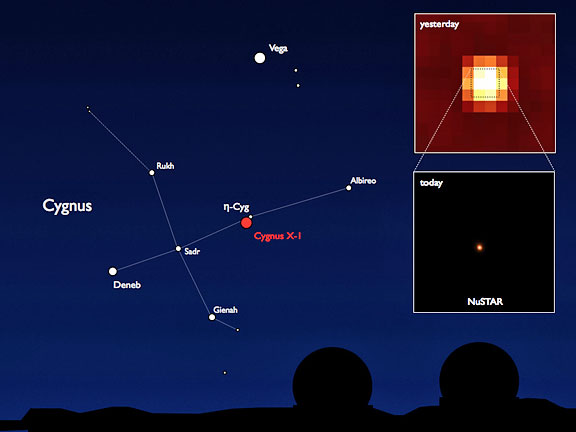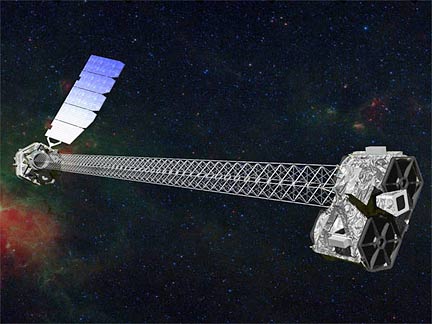At the recent Caltech alumni conference,
Caltech Professor Fiona Harrison presented NuSTAR, NASA’s newest space
telescope. Harrison is the Principal Investigator and creator of NuSTAR.
NuSTAR focuses high-energy X-rays (6 to
79 keV) as never before possible. Each time astronomers have been able
to observe the universe in a new way, they have made remarkable and
unanticipated discoveries. We expect NuSTAR to be equally amazing. And
costing only $160 million, it is bargain-basement by NASA standards.
Because of its focusing lens and advanced
detector, NuSTAR is hundreds to thousands of times more sensitive than
any previous instrument in this energy range.
During its two-year primary mission, NuSTAR will apply its unique capabilities to:
(1) taking a census of neutrons stars and black holes, both in our galaxy and beyond
(2) examining explosion processes in supernovae
(3) analyzing relativistic jets in active galactic nuclei
(4) studying our Sun’s corona.
For 400 years, astronomers have built
telescopes that focused visible light with mirrors and lenses. But
high-energy X-rays are a problem because their “size” (wavelength) is
smaller than an atom. This means that instead of “seeing” the smooth
surface of a mirror they instead “see” the mirror’s individual atoms as
large boulders, so they crash instead of bounce.
Fiona Harrison developed a mirror surface
coating that reflects high-energy X-rays that hit the mirror at a small
grazing angle. The reflection slightly changes the X-ray’s direction,
focusing it onto a detector. Since only a few X-rays will hit the mirror
just right, Harrison’s team built an array of 130 concentric cylinders,
each coated with 400 layers of different materials - the layers are
only a few atoms thick. The long axis of the cylindrical array is
pointed at the X-ray source. The X-rays enter the array at one end and
exit the other end after being slightly focused.
The mirror system is made of glass sheets
that must be as thin, strong, and flexible as possible. The best glass
turns out to be the glass used in iPhones and iPads.
Asked how she managed to construct such
as elaborate mirror system, Fiona replied: “We burned through a lot of
graduate students.”

One of NuSTAR’s pair of cylindrical mirror systems is 1.5 feet long by 15 inches across.
Because the X-rays are only slightly
deflected by the mirror system, the detector must be 33 feet away. Since
that’s too long to be launched in the rocket, an expandable mast had to
be developed. The mast is only 6 feet long when launched and then
unwinds as it spools out to the full 33-foot length.
The entire NuSTAR telescope was loaded
into a modest rocket (Orbital Science’s Pegasus XL) and strapped to the
belly of an L-1011 aircraft. On June 13, 2012, the plane took off from
Kwajalein (the world’s largest coral atoll, midway between Hawaii
and Australia) and flew up to 40,000 feet, where the rocket was
released. The rocket subsequently fired and carried NuSTAR to an
altitude of 380 miles.
Observations have just begun. Shown below
is NuSTAR’s first image, taken of Cygnus X-1, one of the first black
holes ever found. To the right of the sky diagram are two inset images
of Cygnus X-1’s accretion disk; the upper image was taken by the best
prior high-energy X-ray telescope, and the lower by NuSTAR. What a
difference!

With its ability to pinpoint high-energy
X-ray sources, NuSTAR will count and catalog our galaxy’s population of
neutron stars and black holes. It will also be used to study the outflow
of heavy elements in supernovae explosions, hopefully shedding light on
the collapse and explosion processes in these cosmic cataclysms.
NuSTAR’s superior resolution will allow
astronomers to image X-ray emissions from supermassive black holes in
distant galaxies in order to better understand their accretion processes
and impact on their host galaxies.
NuSTAR is also expected to help us better
understand our Sun’s corona, its wispy outer atmosphere that reaches
temperatures over a million degrees and reaches million of miles above
the Sun’s surface. We wish to better understand how this most distant
part of the Sun can be vastly hotter than its surface.
Fiona Harrison explained that NuSTAR is
the realization of a dream she has nurtured for over a decade.
Congratulations to her and her team!
Best Regards,
Robert
September 26, 2012
Note: Previous newsletters can be found on my website.
Artist’s view of NuSTAR in space seen below:

|